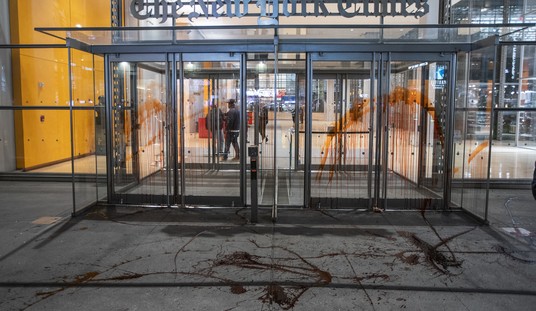Let me put down here some facts that are worth returning to from time to time, as arguments over the history of Islam and Islamism are back in the news with today’s beheading in London. In debates over the history of tension between Muslims and Christians, the Crusades are often cited, out of their historical context, as the original cause of such clashes, as if both sides were peaceably minding their own business before imperialist Westerners decided to go launch a religious war in Muslim lands.
This is not what actually happened, and indeed it is ahistorical to treat the fragmented feudal states of the West in the Eleventh Century as capable of any such thing as imperialism or colonialism (although, as Victor Davis Hanson has noted, even in the centuries after the fall of Rome, Western civilization retained a superior logistical ability to project force overseas due to the scientific, economic and military legacies of ancient Greece and Rome). Moreover, when Islam first arose, much of what we think of today as Islamic ‘territory’ in Anatolia, the Levant and North Africa was Christian until conquered by the heirs of Muhammad, such that speaking of one side’s incursions into the other’s territory requires you to ignore how that territory was seized in the first place. That entire region had been part of the Roman and later Byzantine empires, and was culturally part of the West until it was conquered by Muslim arms – Rome is closer geographically to Tripoli than to London, Madrid is closer to Casablanca than to Berlin, Athens is closer to Damascus than to Paris.
All that said, it’s worth remembering that the Crusades arose in the late Eleventh Century only after four centuries of relentless Islamic efforts to conquer Europe, and the Christians of the Crusading era cannot be evaluated without that crucial context.
It’s somewhat hazy to identify the genesis of the first battle between the Byzantines and Islamic forces, which probably took place around 629 at the Battle of Mu’tah, before Muhammad had even completed the conquest of Mecca; the first sea battle between Muslim and Byzantine forces took place a few years later. The fall of Mecca in 630 solidified Muhammad’s control of the western side of the Arabian peninsula, and Muhammad died in 632. A decisive Muslim victory at the Battle of Ajnadayn in 634 spread Muslim control into modern Israel. Between 634 and 689, Muslim forces conquered Christian, Byzantine-held Syria and North Africa.
Starting in the middle of the Seventh Century, when Islam was still mostly united under a single political entity, you begin to see Islamic incursions into Europe (including Constantinople, which was effectively one of the leading European cities at the time) – and from there, the conquests and attempted conquests marched on. If you look on a map over this period, you see an almost continuous line of advance on Europe from all sides but the north – from Spain and France in the west to Italy in the center to Constantinople in the east to the frontiers of Georgia in the Caucasus, with the islands of the Mediterranean on the front lines:
650-54: Muslim conquest of Cyprus.
652: Muslim Invasion of Sicily begins.
674-78: First Siege of Constantinople, repelled with the invention and deployment of “Greek Fire.”
711-18: Muslim Conquest of Spain, which would not be reconquered completely by the Christians until 1492.
717-18: Second Siege of Constantinople.
719: Muslim invasion of France begins, establishing Muslim control of the Septimania region of southwestern France.
732: Battle of Poitiers (Tours); Charles Martel halts Muslim northward march into central France.
736: Muslim Conquest of Georgia, where the Emirate of Tbilisi would hold sway until 1122.
820: Muslim Conquest of Crete, which would be held until 961.
827: Muslim Conquest of Syracuse in Sicily.
846: The Muslim Sack of Rome by troops landing at the port of Ostia, including the sack of St. Peter’s Basilica while Pope Sergius II and the helpless Roman garrison retreated behind the city walls.
847: Muslim Conquest of Bari in southern Italy; the Muslim presence on the Italian peninsula proper lasted 25 years. In 915, at the Battle of Garigliano, Pope John X personally led an army against Islamic forces in southern Italy
863: In a rare break from the pattern of this era, the Byzantines go back on offensive, with mixed results over the next 200-300 years of warfare.
902: Muslim Conquest of all Sicily. In 965, an independent Emirate of Sicily would be established lasting until 1091.
1048-1308: The Byzantine-Seljuk Wars, yet another continuation of the mutual, longstanding efforts by the Byzantines and their Islamic neighbors to conquer each other’s territory. In 1071, the Battle of Manzikert would prove the first of a series of decisive engagements (followed by the 1176 Battle of Myriokephalon) that gradually wrested Asia Minor from the Byzantines, converting it from a Christian land to a Muslim one and isolating the remaining Byzantine presence to the immediate surroundings of their historic capital of Constantinople.
And, of course, Islamic efforts against Europe and the West would continue well after the Crusades, from the Fall of Constantinople in 1453 to the naval incursions finally stopped at Lepanto in 1571 to the epic Seige of Vienna in 1683 (which in turn was followed by another century of bloody wars between the Ottomans and Hapsburgs).
As has often been noted, the early history of Muhammad as a military leader and Islam as the driving force of conquest is quite different from the early history of Christianity as the persecuted faith founded by a non-violent martyr, and these differing foundations have presented different challenges for Christian and Muslim thinkers dealing with questions of war, peace, and the defense of self and others. That said, none of this is intended to demonize Muslims as uniquely violent in the Dark Ages. Aggressive wars of conquest were the rule throughout the world in those centuries, and have become only fitfully less so into our own age.
But the Crusades did not originate in a vacuum; they were launched in a world where the Roman Empire, the guardian of Western Civilization, had fallen to outside invaders 600 years earlier and European Christians had been on the defensive ever since. The Europe that would stand astride the non-Western world into the middle of the Twentieth Century was still distant in the future. The fearful and divided Christian principalities of 1095 had grown up in a world where Islam, not Christianity, had been the engine of imperial expansion for long before living memory.
Virtually nobody in the West and/or what passes for Christendom today argues that violence can or should be justified on the basis of things that happened a thousand years ago. The insistence of Islamist propagandists on revisiting such ancient history for present-day propaganda purposes should be resisted – but it should also be subjected to the corrective of accurate history. And that history is one in which Muslims carried the sword to Europe for centuries before Christian armies took the Crusade to them.














Join the conversation as a VIP Member